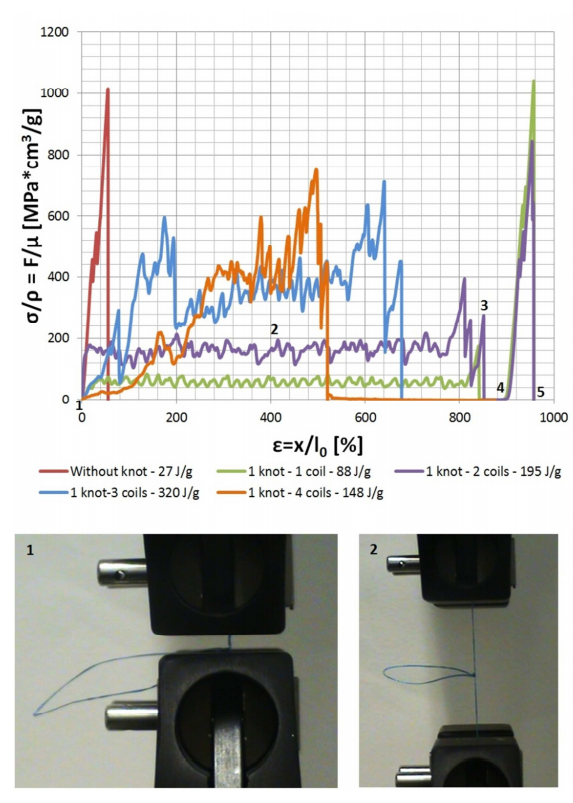Simple Trick Turns Commercial Polymer Into World’s Toughest Fiber

In material science, toughness is a measure of the amount of energy a material can absorb before breaking. Kevlar, for example, can absorb some 80 Joules per gram before breaking but this is dwarfed by certain natural materials which are much tougher. The silk produced by the giant riverine orb spider, for instance, can absorb around 390 Joules per gram before breaking.
So there is great interest in finding new materials that can match or beat the performance of natural materials for applications that require high levels of energy absorption.
Today, Nicola Pugno at the University of Trento in Italy reveals a remarkably simple trick that dramatically increases the toughness of almost any kind of fibre. Indeed, Pugno says he has used the technique to create the world’s toughest fibre.
The new idea is deceptively simple–it involves no more than tying a slip knot in the fibre, creating a loop of extra fibre that can passes through the knot as it comes under tension.
The mechanism is straightforward. When the fibre is placed in tension, the slip knot begins to tighten and the extra material passes through the knot, dissipating energy through friction.
Of course, the fibre eventually breaks but only after all the material in the loop has passed through the slip knot.
Clearly this doesn’t make the material any stronger (toughness and strength are different properties that are generally uncorrelated). However, it’s not hard to see how the energy dissipation would dramatically increase the amount of energy the fibre absorbs before it breaks, thereby increasing its toughness.
Pugno says he has tested the idea on a number of materials using different numbers of loops and slip knots. The best results come from using three slip knots, he says.
By applying this simple trick to a commercial polymer fibre called Endumax, he has increased its toughness from 44 Joules per gram to a remarkable 1070 Joules per gram. That’s the highest value ever recorded. “The proof of concept is experimentally realized making the world’s toughest fibre,” he says.
That’s better even than fibres made from nanotubes which materials scientists are just beginning to make. The strongest of these, made from carbon nanotubes, has a toughness of 970 Joules per gram.
Pugno says his work is just the beginning and that it ought to be possible to use his slip-knot technique to make graphene fibres with a toughness of 100,000 Joules per gram.
There are challenges ahead, of course. Ideally, the force required to pass the fibre through the knot should be just below the material’s breaking point and this depends on factors such as the knot topology. The choice of knot has an important influence on the behaviour of the material and further work here could lead to novel designs. Pugno says he is currently patenting his slip-knot design and so has not yet published it.
The potential applications of this idea are many. Tougher materials could obviously be used in areas where energy absorption is important, such as the manufacture of body armour, for example.
That’s an effective and cheap idea that has significant potential. It’s also extraordinarily simple, which might just be the reason it has been overlooked until now.
Ref: arxiv.org/abs/1304.6658: The “Egg of Columbus” For Making The World’s Toughest Fibres
Keep Reading
Most Popular
Large language models can do jaw-dropping things. But nobody knows exactly why.
And that's a problem. Figuring it out is one of the biggest scientific puzzles of our time and a crucial step towards controlling more powerful future models.
How scientists traced a mysterious covid case back to six toilets
When wastewater surveillance turns into a hunt for a single infected individual, the ethics get tricky.
The problem with plug-in hybrids? Their drivers.
Plug-in hybrids are often sold as a transition to EVs, but new data from Europe shows we’re still underestimating the emissions they produce.
Stay connected
Get the latest updates from
MIT Technology Review
Discover special offers, top stories, upcoming events, and more.